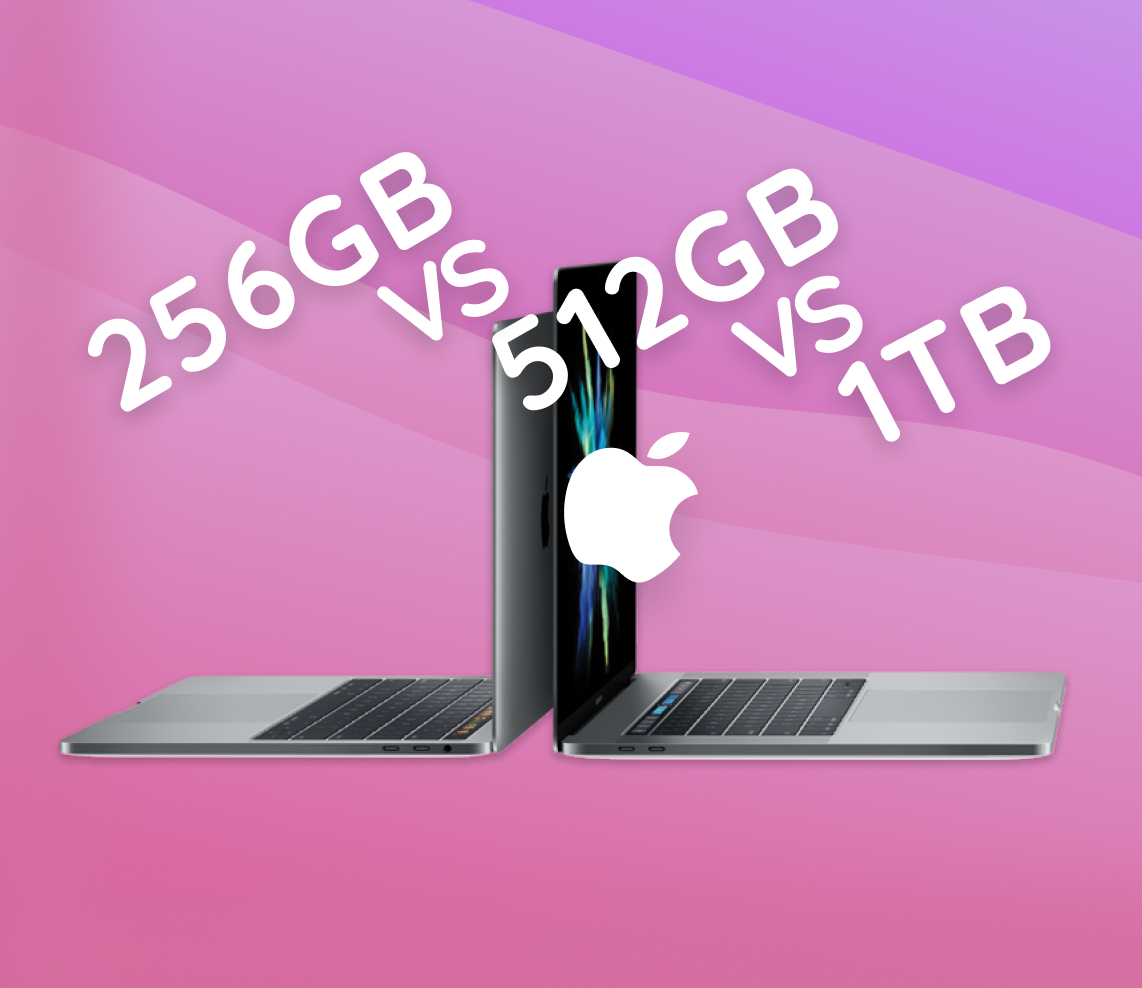The MacBook Air and MacBook Pro are two of the most popular laptop models available on the market with several storage options. If you are considering purchasing a MacBook but unsure of how much storage you will need and wondering, is 256GB enough for MacBook?
Then, this article will provide you with a detailed breakdown of how much storage you need on your MacBook to help you determine the right MacBook for your needs.
MacBook Air/Pro Storage Detailed Comparison
The MacBook Air and MacBook Pro both come in various versions that differ in terms of their processor, RAM, and storage options.

Let us take a closer look at the comparison of the MacBook models, including the prices and their suitability for different tasks.
MacBook 256GB vs. 512GB
| ?️ MacBook Model | ? RAM | ? Storage | ? Price |
| MacBook Air M1 13” | 8GB | 256GB | $999 |
| MacBook Air M1 13” | 8GB | 512GB | $1,249 |
| MacBook Air M2 13” | 8GB | 512GB | $1,499 |
| MacBook Pro M2 13” | 8GB | 256GB | $1,299 |
| MacBook Pro M2 13” | 8GB | 512GB | $1,499 |
| MacBook Pro M2 14” | 16GB | 512GB | $1,999 |
| MacBook Pro M2 16” | 16GB | 512GB | $2,499 |
| MacBook Pro M3 14” | 18GB | 512GB | $1,999 |
| MacBook Pro M3 16” | 18GB | 512GB | $2,499 |
MacBook Air and MacBook Pro have 256GB and 512GB storage options. The MacBook Air is designed to handle basic tasks such as light office work, web browsing, and light photo editing. On the other hand, the MacBook Pro targets those heavy users such as programmers, graphic designers, video editors, and gamers.
The storage capacity of a MacBook, regardless of its model, can affect its overall performance. When your storage is already full, it can slow down your Mac. Given that MacBook Air is designed to be a more affordable option, is 256GB enough for MacBook Air?
Obviously, the one with 512GB of storage capacity is twice as much as the one with 256GB, therefore it can be beneficial for users who need to store extensive files or install heavy applications to use the one with 512GB.
Price-wise, getting the 512GB MacBook will be more expensive than the one with 256GB. But if you are using your MacBook for memory-intensive tasks such as photo and video editing, the 512GB has more advantages than the one with 256GB.
Lastly, if you think ahead of the future and plan to use your MacBook for several years, you may want to consider the one with a bigger storage capacity considering that you will be storing more files and applications in the future.
MacBook 512GB vs. 1TB
If we compare the MacBook 512 vs 1TB, regardless of its model, both of these storage options can handle large amounts of data, but there are a few differences between them that you might consider.
| ?️MacBook Model | ? RAM | ? Storage | ? Price |
| MacBook Air M1 13” | 8GB | 512GB | $1,249 |
| MacBook Air M2 13” | 8GB | 512GB | $1,499 |
| MacBook Pro M2 13” | 8GB | 512GB | $1,499 |
| MacBook Pro M2 14” | 16GB | 512GB | $1,999 |
| MacBook Pro M2 16” | 16GB | 512GB | $2,499 |
| MacBook Pro M2 14” | 16GB | 1TB | $2,499 |
| MacBook Pro M2 Max 14” | 32GB | 1TB | $3,099 |
| MacBook Pro M2 Pro 16” | 16GB | 1TB | $2,699 |
| MacBook Pro M2 Max 16” | 32GB | 1TB | $3,499 |
| MacBook Pro M3 Max 14” | 36GB | 1TB | $3,199 |
| MacBook Pro M3 Pro 14” | 18GB | 1TB | $2,399 |
| MacBook Pro M3 Max 16” | 36GB | 1TB | $3,499 |
Only the MacBook Pro offers a storage capacity of up to 1TB. Some MacBook Pro models are even upgradable to a greater storage capacity.
Comparing the MacBook 512GB vs 1TB MacBook Pro, the 512GB model is suitable for storing a large amount of data, such as software, media files, and documents for users who require ample storage.
On the other hand, the 1TB MacBook Pro is suitable for professional video or photo editors who usually need a lot of storage space as this type of work involves working with large files.
The MacBook 512GB and above models are ideal for gamers since games usually take up a significant amount of storage space. Programmers also prefer the MacBook Pro 512GB or higher models as they require ample storage to store their code and run virtual machines.
Although these two storage capacity options are already substantial, it’s important to remember that when your laptop’s storage capacity approaches its limit, you might experience a slower or lagged operation system.
Is 256GB of Storage Enough for a MacBook?
As discussed earlier, the amount of storage you need on your MacBook depends on your usage. The MacBook Air and MacBook Pro 256GB models are suitable for general use and ideal for college students, writers, and people who use their computers to browse the internet and do basic tasks. However, if you are a professional who needs to store large files, such as high-resolution images or videos, or run multiple virtual machines, then you’ll need more storage.

How to Deal With Insufficient Storage Capacity
If your MacBook is running out of storage, there are several ways to deal with insufficient storage capacity on your MacBook.
?️ Expand Your Storage in iCloud
When you encounter insufficient storage capacity, one solution is to store or transfer your files to iCloud. This will allow you to free up space on your device when storing your files like photos, documents, and other data in iCloud. The good thing about storing your files in iCloud is its accessibility. You can access your stored files anywhere as long as you have an internet connection.
? Use External Drives
You can transfer your files to external drives to deal with insufficient storage capacity. Using external drives is as simple as plug-and-play. It will serve as an extension of your storage capacity externally. The most common external drives widely used today are USB flash drives.
?️ Learn Proper Storage Management Techniques
Using the Store Management feature in your MacBook’s menu will help you determine which files take up the most space on your device, and you may consider deleting them. You can also check for applications that you haven’t used in a while and remove them as these apps pile up and together take up a big chunk of your storage.
Conclusion
When deciding on how much storage you need for your MacBook, you must consider your usage and specific needs. While a 256GB MacBook model can suffice for general tasks like browsing the internet or word processing, more storage is required for professional purposes such as video editing or programming. Furthermore, options like cloud storage services, external drives, and proper management of disk space allow for expanding storage capacity.
By comprehending your usage and taking advantage of available storage options, you can ensure that your MacBook has the necessary storage capacity to fit your needs.
FAQs
The amount of storage your MacBook has depends on the model and specification. You can check the storage capacity of your MacBook by clicking the Apple menu and selecting “About This Mac.” The storage capacity is listed under “Storage.”
The answer to this question depends on do you plan to use your MacBook Air. If you’ll use it for general purposes, such as for office work, internet surfing, or relatively small applications, a 256GB model is enough. However, if you want to use it for heavy applications such as video editing apps that require storing large files such as photos and videos.
The 256GB MacBook Pro is a good choice for people who use their MacBook for general tasks such as browsing the web, checking email, and word processing. However, if you need to store large files or use your MacBook for professional purposes, you may need more storage.
The amount of storage you need for programming depends on the programming languages and tools you use. If you use lightweight languages and tools, a 256GB MacBook Pro may be sufficient. However, you may need more storage if you use heavy tools and work with large files.
For those who use their MacBook Air for everyday activities such as web browsing or document handling, 256GB is usually sufficient. This storage option is cost-effective for users whose needs don’t include heavy video editing or large file storage. Additionally, leveraging cloud storage for extra files can make this option even more viable.
Opting for 512GB on a MacBook Air is beneficial if you regularly work with large files, such as high-resolution images or extensive software programs. It’s also a good choice if you expect your storage needs to increase over time. The extra space provided by 512GB reduces the need for frequent file transfers and provides a buffer for accumulating data.
The decision between 256GB and 512GB for the MacBook Air M1 hinges on your storage needs. The 256GB model is adequate for basic tasks and light media use, making it a practical choice for everyday users. If you engage in tasks that require more storage, like extensive photo editing or large file management, the 512GB model would be more appropriate.
When choosing between 256GB and 512GB for the MacBook Air M2, consider your current and future storage needs. If your use is primarily for standard tasks and media consumption, 256GB should meet your needs. However, for more demanding tasks or future-proofing your storage, 512GB offers additional space, accommodating larger files and more complex applications without the need for frequent data management.
